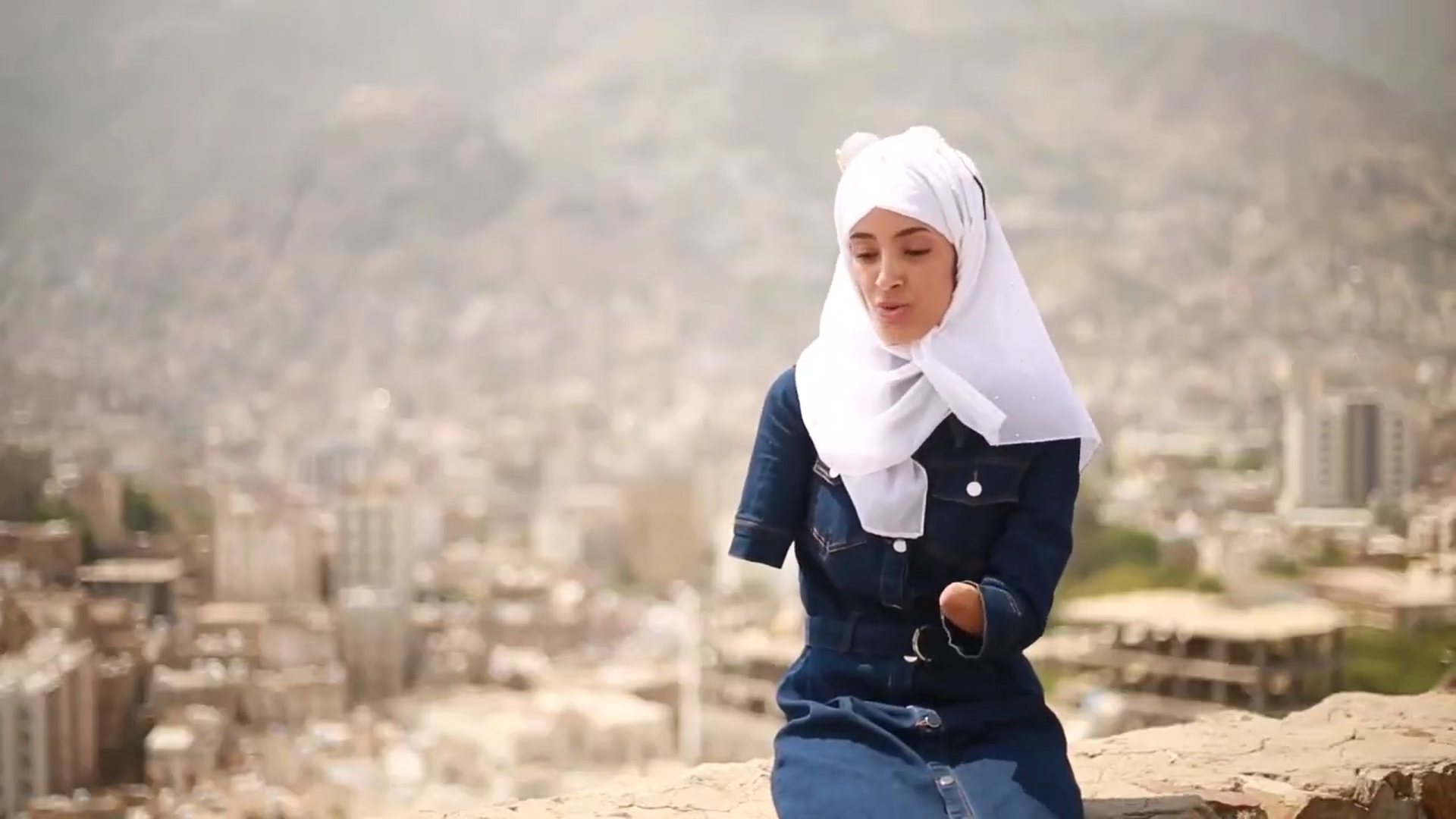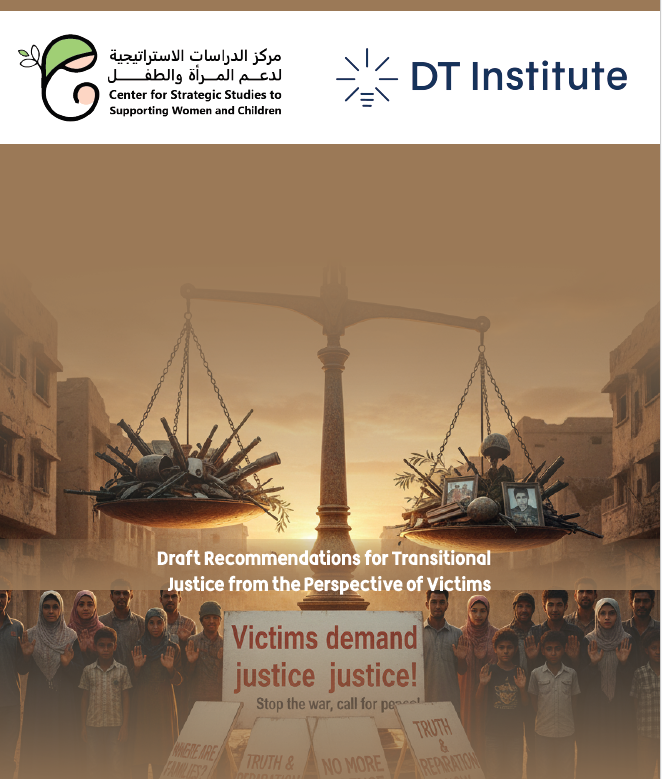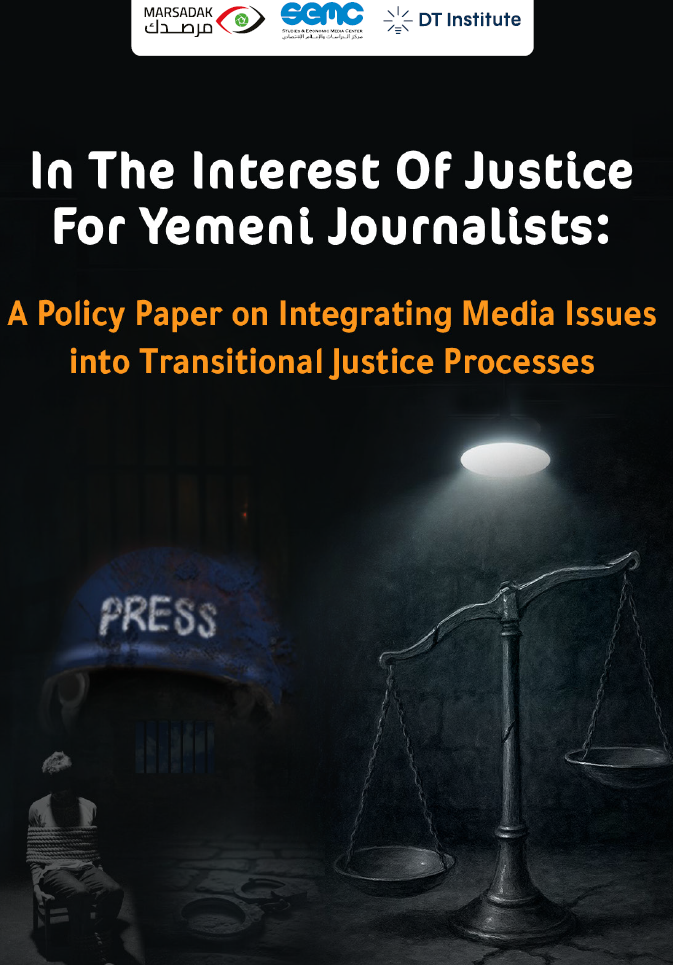Overview of the SPARK Program
In June 2025, five members of the Justice4Yemen Pact (J4YP), a coalition of 10 Yemeni civil society organizations, joined the SPARK team, composed of DT Institute and its local partners, the Abductees’ Mothers Association (AMA) and SAM for Rights and Liberties (“SAM”), to launch advocacy campaigns to complement and expand the geographic scope of restorative justice pilots and raising awareness initiatives in Taiz and Marib.
The pilots aim to foster reconciliation and resolve community-level public disputes that have caused human rights violations. While the advocacy campaigns focus on raising community awareness of transitional justice – its mechanisms, opportunities for engagement, and importance for sustainable peace in Yemen – enabling replication of reconciliation mechanisms and community involvement in national transitional justice processes.
This model was designed in response to the findings of The Path Towards Peace, a research study published by SPARK in April 2025. This study captured local understandings of transitional justice (TJ) across Yemen, revealing that 64.3 percent of community members prioritize reconciliation and war-ending efforts over retributive accountability. Moreover, it further revealed that 51 percent of the research sample had no knowledge of transitional justice at all – identifying a crucial need for education. Participants identified clear roles for civil society: initiating dialogue and reconciliation, offering legal and financial aid to victims, raising TJ awareness, and documenting violations.
To address these gaps, SPARK works to strengthen locally owned mechanisms of reconciliation that respond to community demands for peace over retribution. At the same time, the program builds resilience within divided communities, creating sustainable pathways for dialogue and conflict resolution. Through inclusive approaches, such as victim-centered advocacy campaigns and innovative cultural initiatives, like music for reconciliation, SPARK ensures that women, youth, and marginalized groups are not only participants, but central drivers of Yemen’s transitional justice journey. With donor support, these efforts can be scaled to reach more communities, ensuring that reconciliation and peace take root from the group up.
Initiative Spotlight: Transitional Justice Through the Eyes of Victims
SPARK’s focus on community- and victim-led transitional justice is crucial. Victims and their broader communities – also victimized by the ongoing conflict – are the best sources on the violations and harm inflicted upon them, their resulting effects, and their individual and collective needs going forward. Addressing these serious concerns is an imperative aspect of transitional justice that must be at the forefront of any transitional justice process to foster sustainable change and peacebuilding in Yemen.
Civil society, political parties, and governmental actors, including local authorities and judicial and security agencies, must also be considered and included within transitional justice considerations – as their cooperation and involvement is required for whole-of-society, national processes.
Under the Transitional Justice Through the Eyes of Victims Initiative, J4YP partner, the Center for Strategic Studies to Support Women and Children (CSWC), engaged in comprehensive research culminating in the publication of a study providing an up-to-date analysis of victims’ transitional justice recommendations. The study, entitled From Victims to Vision: Draft Recommendations for a Just Peace in Yemen, utilized specialized reports, field studies, and direct opinions provided by transitional justice stakeholders (most significantly, victims) to draw out actionable recommendations as put forth and in the interest of victims.
The recommendations were drawn from specialized reports, field studies, and direct opinions provided by political parties, local authority representatives, judicial and security agencies, civil society actors, and – most prominently – victims. They addressed all parties to the conflict (both individually and collectively), the international community, the media, and non-governmental organizations.
The recommendations focused on providing victims’ perspectives on transitional justice and aligning it with their aspirations for Yemen. CSWC utilized the information provided in specialized reports, field studies, and the opinions of other relevant stakeholders, including civil society and political actors, to further inform and amplify victims’ transitional justice opinions.
Key recommendations included a ceasefire and humanitarian truce; implementation (on behalf of national parties) and support (on behalf of international parties) of transitional justice initiatives, including national memory-keeping, reparations, acknowledgement, and accountability mechanisms; and ensuring the participation of victims and civil society in peace processes.
More specific recommendations were also provided by victims to specific groups, including to the internationally recognized government (IRG), local and international non-governmental organizations (NGOs), political parties and components, official and national media, and the Saudi-led Coalition. Each of the individualized recommendations provided complemented the others, lending to victims’ vision and hope for Yemeni transitional justice.
These included prioritizing judicial reform and reintegration of security services and combatants into one entity (for the IRG and Saudi-led Coalition). Victims also recommend NGOs strengthen efforts to monitor and document violations, build the capacity of activists and community members alike, and coordinate legal, economic, and psychosocial campaigns to empower victims. Victims further emphasized the importance of adopting a unified national transitional justice narrative in their recommendations to political parties and components, while similarly recommending that official and national media engage in the spread of transitional justice concepts to raise awareness.
💬 “With one voice, we stand for transitional justice and for the battle to rid the country of militias.” – Sami Al-Hamidi, local journalist and victim-participant in CSWC’s Transitional Justice Through the Eyes of Victims Showcase
Learning, Documentation, and Replication
The paper was published via the J4YP website and CSWC’s social media in both English and Arabic in both English and Arabic. It was additionally shared with prominent stakeholders, including the UN Entity for Gender Equality and the Empowerment of Women (UN Women), Inclusive Peace, the Cairo Institute for Human Rights Studies (CIHRS), the International Center for Transitional Justice (ICTJ), among others. . It was additionally shared with prominent stakeholders, including the UN Entity for Gender Equality and the Empowerment of Women (UN Women), the UK Foreign, Commonwealth, and Development Office (FCDO), the US Department of Foreign Affairs (DFA), the Cairo Institute for Human Rights Studies (CIHRS), the International Center for Transitional Justice (ICTJ), among others.
To boost awareness of the paper’s publication, CSWC also published a video in which activists and human rights advocates provided transitional justice messages in solidarity with victims, which garnered over 720 views on CSWC’s Facebook alone.
CSWC also sought to empower victims by providing them with platforms to speak out about the atrocities and to share their experiences (as documented by CSWC during their interviews) with the broader public. In doing so, CSWC engaged victims of the 2015 Taiz siege, further complementing publication of the paper and SAM’s Tanker Massacre Restorative Justice Pilot – which achieved official recognition, in the form of the Memory Museum for victims of the 2015 Siege on Taiz.
CSWC also engaged victims from similar atrocities, including the Al-Bab Al-Kabir Market Massacre, Wadi al-Qadi Massacre, and another massacre in which two children were killed and 16 were injured in cross-fire exchanges between the conflict parties.
Through engagement with victims in preparation for the report, CSWC published a video, in which the victims demand justice and recognition by conveying their experiences. Moreover, the CSWC implemented the Transitional Justice Through the Eyes of Victims Showcase, hosted on September 15, 2025 at Belqees Hall in Al-Taawon Park.
💬 “I lost my childhood, but I hope to live the rest of my life with more justice and peace. This conflict must come to an end.” – Hadeel Abdulwase, victim of a missile attack, whose photo and story were shared within the SPARK Memory Museum and victims’ video demanding justice.
The victim-participants for the video and showcase were selected after consultation with victims in preparation for the recommendations report, according to their willingness, engagement, and informed consent. In selecting participants, CSWC was also careful to ensure that this initiative complemented, rather than duplicated, other local activities, including the Memory Museum.
Their efforts were extremely effective, culminating in the recognition of victims through various means and mediums. As one of the showcase participants reflected upon his engagement with the Memory Museum, “I was with my friend…who lost his leg to a shell, and I, who lost my eye and leg to landmines. … Every corner of the museum told a story of a tear, a scream, or a life that was stolen… However, this memory remains a beacon of hope, reminding us that what we have lost must be transformed into strength, and that what we have lived through must be a motivation to make peace that preserves the lives of future generations.”
Through the video and showcase, CSWC enabled these victims to share their stories, struggles, and extraordinary ability to overcome their traumatic experiences. In sharing their stories, the victims did not solely focus on the violation experienced or their resulting trauma but went further to share their experiences in demanding accountability, justice, and recognition of their individual atrocities.
One victim, Hadeel Abulwase, shared her experiences in CSWC’s video report after losing both her hands in 2017 when missiles struck her home. Hadeel explained the despair she felt and the strength it took to overcome her experiences. “I wished I had died at that moment,” she said. However, with her family’s support, Hadeel began looking at her disability differently. “I started using my legs to write, because I believe that disability is in the mind, not in the hands.” In spite of the violation, its resulting trauma and disability, she completed high school and is continuing to pursue her dream of studying media as a second-year student.
Hadeel’s vision of justice, as shared in the video, is focused on ending the conflict. She dreams of spending the rest of her life enjoying justice and peace in Yemen. “This conflict must come to an end,” she reflected, outlining her motivation in sharing her story and highlighting the atrocities committed upon her.
In the showcase, victims utilized posters, photos, and audio and visual recordings, of their experiences throughout the showcase, which was further divided to include six separate, interactive installations. These installations included a live painting station, an area for participants to engage in dialogue with victims, and installations requesting participants’ feedback and asking them to write messages to decision-makers, outlining their hopes for transitional justice.
The showcase event drew participation from over 70 attendees, including representatives from local authorities, activists, and civil society. The artworks and live storytelling created moral and psychological pressure, pushing decision-makers, who attend the workshop or hear about its activities from locals, to take steps towards justice and reconciliation
Broad media coverage furthered the scope of the showcase as attendees and media outlets documented the initiative, praising its impact on the community. Local journalist and CEO of Press House, Mohammed Al-Haribi took to his Facebook page to individually thank and praise the victims involved in this initiative.
He shared, “This important event showcased inspiring stories of victims who overcame the challenges of disability they faced as a result of the Houthi war against Yemen and Yemenis. These stories have provided inspirational experiences for youth and women, most notably Jihad Al-Buraihi, Walid Al-Qudsi, Hadeel Mohammed, Sami Al-Hamidi, and Younis Ismail. Documenting victims’ stories is a sound start to ensuring transitional justice in Yemen.”
Online engagement from attendees, including Mohammed, who has over 11,000 Facebook followers, generated further engagement. Community members and local and citizen journalists interacted with their posts, expressing praise and generating further discussion.
The event was also covered by local news outlet, Suhail Channel, which posted a video to their YouTube Channel with over 1.29 million subscribers. To further the reach of the event to online audiences, CSWC also published a video depicting the event, which garnered over 650 on CSWC’s Facebook alone.
In response, CSWC’s social media skyrocketed over the project period – reaching over 16,200 individuals (a 188 percent increase compared to the previous period) and garnering over 45,300 views (a 59 percent increase). Users interacted more with CSWC’s content as well – link clicks nearly tripled, and engagements increased to 1,200 (a 114 percent increase from the previous period). The numbers reflect the content’s resonance with the audience and greater community, echoing the sentiments expressed by attendees in their comments and posts.
Moreover, this project and coordination with victims resulted in establishment of a partnership between CSWC and another local actor, Press House Foundation. Under this initiative, CSWC and Press House will be building off of the impact and documentation conducted during this project to further assist the victims.
Scaling the Impact
The urgent need for transitional justice in Yemen is clear. Moreover, after over a decade of failed national peace talks in which victim and community needs were disregarded, the urgent need for victim- and community-led transitional justice is even more clear. The role of civil society and the goal of the SPARK program is to foster and provide the necessary skills, tools, and knowledge required by local communities to lead such transitional justice processes as part of Yemen’s national peacebuilding.
“Past failed peace talks have always included one key feature: total ignorance towards the wants and needs of the public – the true victims of the Yemen conflict – to their detriment. This time around, we are working to change this by thoughtfully seeking out victims’ transitional justice recommendations and by providing victims with the necessary resources and empowerment (which includes raising awareness and education of transitional justice and conducting further psychosocial and legal support) to enable them to truly engage in transitional justice,” shared DT Institute Program Officer, Lynn Arbid. “We must continue to build off of this momentum and victims’ excitement to engage on transitional justice – especially while so many life-threatening distractions persist.”
By raising awareness of transitional justice and compelling victims to consider their transitional justice recommendations and needs, advocacy campaigns foster a sense of community responsibility to operationalize transitional justice principles. They envision transitional justice efforts, rooted in local ownership, dignity, and dialogue, serving as foundations for broader restorative justice pilots and raising awareness initiatives.
Yet the scale of the challenge far exceeds current resources. With greater donor investment, SPARK could expand restorative justice pilots to additional governorates, reaching thousands more Yemenis with awareness campaigns and victim-centered initiatives and strengthening the capacity of civil society to engage directly in national dialogues on reconciliation. It would also allow the SPARK team to replicate innovative approaches to actualize and complement victims’ transitional justice recommendations as provided by CSWC’s From Victims to Vision report.
These include creating a national roadmap for justice and reconciliation that integrates lessons from previous reports and studies, amplifying victims’ voices, and institutionalizing mechanisms that link transitional justice with peace negotiations, ensuring justice is part of the political agenda, not a delayed issue. This is a unique opportunity for donors to invest in scalable, locally led solutions that bridge the gap between grassroots reconciliation and national peacebuilding.





